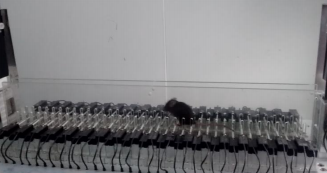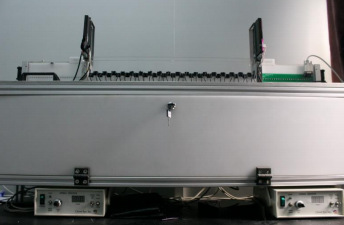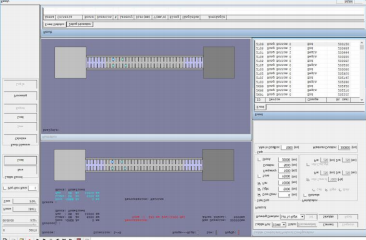LadderScan is our latest addition to our product lines for motor function, and the new one for motor learning. Like our comprehensive full body motor function measurement product HomecageScan, limb specific motor function of Gait Analysis Suite of products, and simple open field test for basic motor function TopScan LITE, LadderScan provides another measurements of visually-guided motor function, and it also provides motor learning function that is usually hard to measure without expensive equipment and surgery!
The LadderScan is a fully automated test for detecting motor performance, associative motor learning deficits and cognitive phenotypes in mouse models. The LadderScan consists of a horizontal ladder in between two shelter boxes. Each shelter boxes are equipped with automatic doors, tones, fans and shockers. All these stimuli are used as cues for departure. They control the speed of the mice and to prevent them from leaving the shelter box at the opposite side and crossing the ladder at unwanted moments. These provide user with the capability of various powerful and flexible experiment configurations.
Two automatic doors are installed at both ends of the ladder which controls animal’s walking in and out. Two small enclosures are used at both ends to make animal confortable to walk to the end. which are equipped with a bright white LED spotlight in the roof and two pressurized air outlets High pitch tone and Both, light and air stimuli are used as cues for departure. In addition, one of the air outlets is used to control the speed of the mice and to prevent them from leaving the shelter box at the opposite side and crossing the ladder at unwanted moments (which we call ‘escape’)..
The ladder has 2 × 37 rungs for the left and right side. All rungs are touch sensitive sensors,, which are continuously monitored and which can be used to register and analyze the walking pattern of the mouse instantaneously. Moreover, based upon the prediction of the walking pattern, the rungs can be moved up or down by a novel device. The computer system (runs the real-time system recording sensor data, adjusts air pressure, predicts future touches, calculates interventions, repositions slides and stores data, operates in a fixed cycle of 2.
The LadderScan (see figure ) is a horizontal ladder on which mice can perform several visually-guided stepping paradigms. The mouse traverses this ladder while the touch sensitive rungs. This allows the system to measure step time and length, missteps, back steps, and jumps, while cerebellar functioning is tested in a challenge that involves a barrier raising during the run. Classical conditioning could be performed on a horizontal ladder by presenting a tone just prior to raising or lowering a ladder rung in the path of the moving animal. Furthermore, evidence suggests that this form of associative motor learning would likely be cerebellum-dependent: unexpected ladder rung perturbation during visually guided stepping caused modulation of activity in the cat cerebellar cortex and deep cerebellar nuclei
Figures on the right show the raising and lowering of a ladder.



